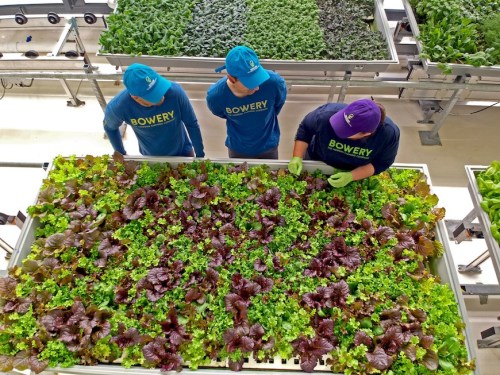How indoor farming is making it easier to eat locally grown, pesticide-free food
See how tech-y, indoor farming is providing better access to locally grown, non-GMO produce.

As a farmer, your entire job is at the mercy of the weather. A scorching hot growing season with no rain or, conversely, too much rain could ruin your entire crop yield. And then you’re screwed. Or at least, that’s how it’s been for centuries.
Bowery, an indoor farming startup with locations in New York City and New Jersey, has moved the whole operation indoors. And doing so has yielded a perfect crop virtually every time. The company uses cutting-edge technology to make every part of the growing system controllable. “We’re able to give the plant exactly what it needs, exactly when it needs it throughout its entire life,” CEO and co-founder Irving Fain says. “So we really control that process from seed to store.”
To build this tricked-out farm, Fain and his team started with a warehouse. It’s filled floor to ceiling with stacked shelves of potted romaine, bok choy, kale, butterhead lettuce, arugula, cilantro, parsley, and basil, with LED lights shining their artificial sunshine on each level. After being harvested, they greens will be packaged and shipped out to Whole Foods locations across the tristate area, along with Dig Inns and Sweetgreens throughout the northeast.

Fain calls the specially designed operating system the “brains of the farm.” And while he won’t give me a rundown of exactly how it works (that’s proprietary info), he does say that the system has sensors that collect data about the crops every step of the way. “Millions of data points in real time [gets] taken in and analyzed,” he says. Through an algorithm, Bowery’s staff is able to pin-point the optimal growing conditions for each crop, everything from how high the LED lights should be turned on to the temperature of the room to the optimal time to harvest the crops. “We’re constantly monitoring, iterating, and adjusting,” Fain says.
Because they can be so specific and aren’t beholden to growing seasons (they can grow everything indoors all year round), Fain says they can grow more full crop cycles each year than traditional farms. He also says their technology can ensure the produce consistently taste good. “If you think about wine, for example, the reason why a specific vintage wine is favored is because the growing conditions were optimal during that specific year. We have the capacity and the capability to control all these external variables at a very minute level all the time for all of our crops,” he says. So the crops produced by Bowery, according to Fain, are the best you can get that are grown without pesticides, other chemicals, or genetic modification.
The farther food has to be shipped, the older (and less fresh) it will be when you buy it. “[An estimated] 50 percent of nutrition in produce is lost from the time it is harvested to the time you eat it,” Fain says.
This isn’t to say that indoor farming should (or can) replace traditional farming entirely. Our country is rich in farmland that produces delicious, nutrient-dense food that is eaten not just here in the States, but worldwide, and organic farming is bigger than ever in the US. But Bowery is creating a model that can be replicated in cities throughout the country, providing a way to eat food grown closer to home. After all, the farther food has to be shipped, the older (and less fresh) it will be when you buy it. “[An estimated] 50 percent of nutrition in produce is lost from the time it is harvested to the time you eat it,” Fain says.
While Bowery purports to be the most high-tech indoor farm, other cities across the country have their own to brag about. Cincinnati is opening a 150,000-square-foot one, which will supply several grocery chains in the area with greens, herbs, cherry tomatoes, cucumbers, and peppers. Las Vegas is home to one of the biggest, operated by startup Oasis Biotech, which grows and supplies greens and herbs to many of the city’s restaurants. Both use LED and hydroponic systems to get the job done.
As more cities adopt indoor farming, more people who never would have considered a career as a farmer before can go into the field without, you know, going “into the field.” “Besides people with agricultural plant knowledge, we also have folks who have data science experience, computer vision experience, software engineers, hardware engineers, mechanical engineers, and electrical engineers,” Fain says of Bowery.
With all of the pros of indoor, vertical farming, it certainly seems like the future of farming—and organic eating—is looking up.
The farmers’ market is of course another way to get locally grown food. Here are eight insider shopping tips, plus what a dietitian buys when she’s there.
Sign Up for Our Daily Newsletter
Get all the latest in wellness, trends, food, fitness, beauty, and more delivered right to your inbox.
Got it, you've been added to our email list.








